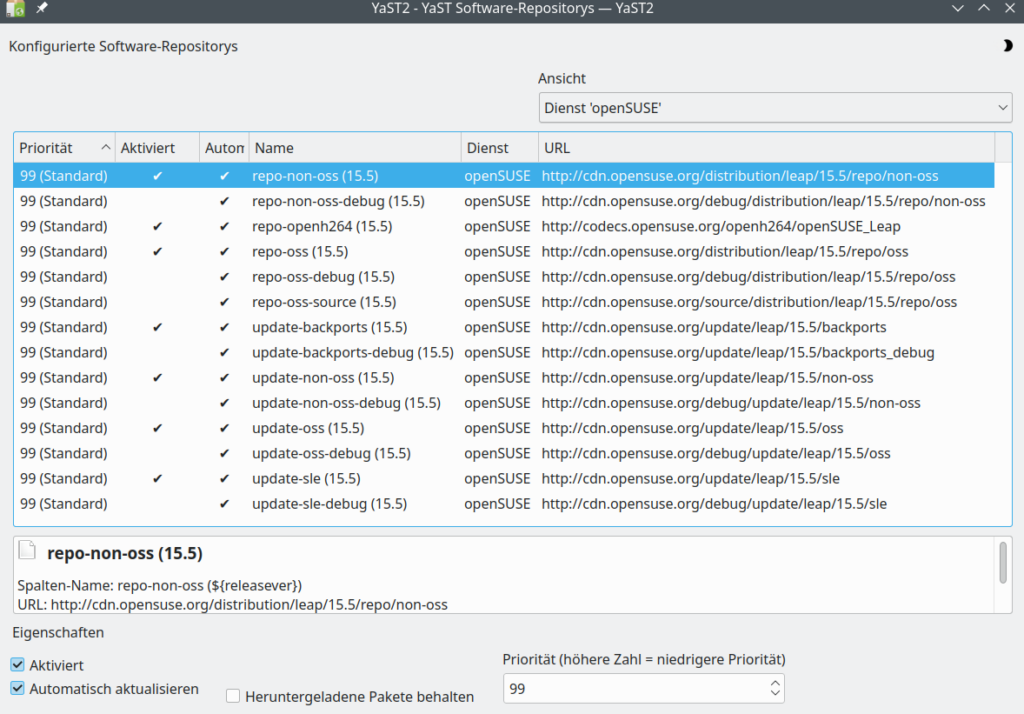In one of the last posts I have said that upgrades of running Opensuse Leap 15.4-systems to Leap 15.5 are a smooth business. However, a major bug in the present Leap 15.5 did not appear on my radar until now.
During the upgrades of most of my systems I just continued using a system-specific bunch of active Opensuse repositories – like the “graphics” and the “security” repositories. I used the ${releasever}-mechanism during the upgrades to point zypper to the new versions of the repositories. This all went well and after the upgrade I found the 15.5-versions of those repositories, which I had used on Leap 15.4 before, integrated into the YaST2-software and package management of Leap 15.5.
But, two days ago, I installed Leap 15.5 on a laptop from an ISO-image on a DVD. Such an installation only sets up basic Leap 15.5 repositories. So, after the installation I wanted to add further repositories via YaST2’s software-management. This did not work at all. The repositories simply did not appear in the list of managed repositories afterwards.
I fiddled around for about an hour. It became clear by switching views on repos and so called “services” that the requested new repositories were handled by YaST as SW-services, instead as standard repositories. Whatever “services” are going to be good for in the future. I could find some information at
https://news.opensuse.org/ 2023/07/31/ try-out-cdn-with-opensuse-repos/.
I moved in the end to zypper on the command line to add repositories. Which worked …. A good reason to suspect a bug.
Bug: Adding repositories with YaST2 does not work presently
Indeed: The following two links showed that other Opensuse users had the same problem and that there is a related bug-entry at Opensuse’s bugzilla:
https://forums.opensuse.org/ t/ cant-add-repos/ 171641
https://bugzilla.opensuse.org/ show_bug.cgi?id=1218399
Well, YaST2 is a central tool-box for Opensuse systems. And who would deny that the package manager is one of the most important tools on any Linux system? So, old kinds of questions regarding quality assurance came to my mind: Are changes to central Leap components tested thoroughly at Opensuse? In particular as also SLES is affected …. Unbelievable …
The affected package is yas2-packager 4.5.17-150500.3.3.1.

Workaround
Adding repositories directly via zypper (which is used by YaST2) still works. So, you can add add repositories like the security repository, with command analogous to the following:
mytux:~ # zypper ar -f https://download.opensuse.org/repositories/security/15.5 security Adding repository 'security' ..................................................................................[done] Repository 'security' successfully added URI : https://download.opensuse.org/repositories/security/15.5 Enabled : Yes GPG Check : Yes Autorefresh : Yes Priority : 99 (default priority) Repository priorities are without effect. All enabled repositories share the same priority.
These repos afterward appear in the YaST2 packet manger and are fully usable to install RPM packages.
Weird aspect of the YaST2 packet manager: Opensuse and Nvidia services cannot be deleted via YaST2
After some updates of leap 15.5 you may find that all basic repositories have been switched to “services” at “cdn.opensuse.org”. What is disturbing: A fresh installation of Leap 15.5 from an ISO-image does not show any of the services displayed in the image above.
Once you got the “services” in your Leap 15.5 installation you may want to delete them and restrict your system to the standard repositories at “download.opensuse.org”. But this does not work with YaST2. Which appears as an additional bug. You may switch to “services” and delete them in the views coming up. And everything afterward gives you the impression that they are gone. But no: After a restart of YaST2 and the packet manager all Opensuse services appear restored again.
Conclusion
YaST2’s present packet manager for Leap 15.5 has a major bug: Repositories can not be added. In addition one cannot get rid of the new Opensuse services. Let us hope that we get a new and error free version of YaST2’s packet manager soon.

